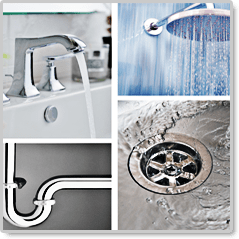Great article from 1st Rate Inspections.
Plumbing problems in your home can range from minor visible nuisances to hidden troubles that can be causing major damage to your home and your family’s health. This article discusses common household plumbing problems, and what you can do to avoid them.

Clogged Drains
Clogged drains in your sinks and tubs are definitely a nuisance, and when they get bad, they can cause water to overflow and flood parts of your home. The best way to deal with clogged drains is to prevent them from happening in the first place.
First, try to avoid putting things into your drains that tend to cause problems. A simple way is to add a strainer to your sink, tub or shower. It’s a lot easier to clean a strainer than it is to clear a clogged drain. Also, avoid putting fats, grease, cooking oil or coffee grounds down your drains, as these will tend to cause clogs to build up in your pipes (see types, costs, and reviews of: sink strainers; sink cleaning tools).
And next, you can prevent clogs from forming by routinely treating your drains by pouring baking soda into them, and then flushing them down with very hot water. This will help dissolve the grease and loosen small clogs before they become bigger ones. The frequency of how often you will need to treat your drains will depend on how often you are having problems with a particular drain.
For example, you may need to treat a bathroom sink only once a year, where your kitchen sink may need it once a month or even once a week.
And also, routinely treating your sinks with baking soda is also much better for the environment than waiting until you have a full clog and then having to use harsh chemicals (see costs and reviews of: sink cleaners; baking soda).
Hidden Leaks
Even very small leaks can cause very big problems if they are allowed to continue unchecked. Unsuspected leaks create a situation of on-going dampness which creates a ripe environment for mold, pests and rotting to thrive.
There are a couple of things you can do to prevent problems from hidden leaks.
First, several times a year you should take a flashlight and look in the cabinets below your sinks for any signs of dampness.
Next, you should also look around the bases of your toilets for any indications of leaks. And to check to see if your toilet is leaking from the tank to the bowl because the flapper valve isn’t sealing tight enough, you can put a couple of drops of food coloring into the tank of your toilet, and then come back after an hour or so to see if the water in the bowl is showing any signs of the color (helpful accessory: leak repair kits).
Poor Water Quality
Poor water quality can show up as obvious problems, such as bad taste, color, or odors. But poor quality can sometimes be from unseen factors, which can be very unhealthy for your family.
The first step in dealing with poor water quality is to get your water tested (see costs and reviews of water quality testers). Most good hardware stores will sell test kits which you can use to evaluate potential problems with your home’s water quality.
Some water quality problems can be remedied by installing a water softener. While others can be solved by installing a whole-house water filter. And sometimes all you will need to do is install a simple point-of-use filter for your sinks or shower heads (see costs and reviews of: water softeners; water filters).
For example, a common problem which is finally getting more attention is the dangers associated with high levels of chlorine in household water supplies. There are a number of health problems caused by drinking water which has high levels of chlorine, but the bigger risk is from taking showers using water that has high chlorine levels. The heat and steam of a shower opens skin pores which increase chlorine absorption into your body, and the steam that you breathe in the shower can contain up to 20 times the concentration of chlorine as in tap water.
The good news is that these problems can be addressed by installing filters on your shower heads and sinks where you get your drinking water.

